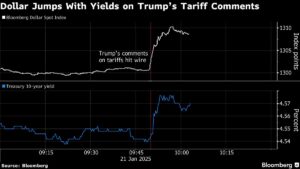The Dollar’s Resilience Amid Tariff Speculations: A Closer Look
In recent trading sessions, the U.S. dollar experienced a notable rebound following its steepest decline in over a year, primarily fueled by speculation surrounding President Trump’s potential tariff implementations. This volatility in the currency market underscores the intricate link between trade policies and currency valuations.
The Market Response
On a day when the dollar gauge rose by as much as 0.7% during Asian trading, the implications of Trump’s statements about potentially imposing 25% tariffs on Mexico and Canada sent ripples through financial markets. The immediate response from the currencies of these two nations was a decline of more than 1% against the dollar before a slight recovery. This reaction reflects the market’s sensitivity to tariff-related news and its potential consequences on inflation and interest rates.
Market strategist Rodrigo Catril from National Australia Bank pointed out, “If 25% tariffs on Mexico and Canada are coming, then surely bigger tariffs on China will be following shortly after.” Such forecasts hint at the dollar’s potential to maintain its strength, driven by rising inflation expectations tied to these tariffs.
Understanding the Dollar’s Dynamics
It’s critical to recognize that the dollar fell immediately following Trump’s inauguration amid expectations that his administration would refrain from imposing immediate tariffs. The volatility suggests how reactive traders are to any news regarding tariffs, which can significantly impact trade relationships and economic sentiment globally.
Trump has previously signaled intentions for aggressive tariffs on imports from countries like China, with proposed rates as high as 60%. This aggressive posture has contributed to the current nervousness in the $7.5 trillion foreign exchange market. The Federal Reserve’s cautious stance towards interest rate cuts—especially in the context of economic growth bolstered by potential tariff hikes—further supports the dollar’s resilience.
Rate Cut Speculations and Economic Implications
Recent data indicates a growing sentiment that the Fed may cut the benchmark interest rate more than once in the coming year, with future expectations rising from 46% to 69% in just a few days. Institutions like SMBC Nikko Securities and Nomura have also indicated a potential decline in U.S. yields, which could further influence currency valuations.
In the wake of these tariff discussions, Treasuries rallied as trading resumed post-holiday, reflecting a general risk-off sentiment amid the uncertainty of trade policies. The yield on benchmark U.S. Treasuries dropped by nearly 10 basis points to 4.53%, showcasing a flight to safety by investors.
The Impact on Global Markets
In connection to the dollar’s movements, the offshore yuan slipped by 0.4%, affecting risk-sensitive currencies such as the Australian and New Zealand dollars. However, the People’s Bank of China has indicated support for the yuan by setting the reference rate at its strongest level since early November. This pattern demonstrates the complexities of global currency markets and the interdependence of trade and economic policy.
Alvin Tan of RBC Capital Markets noted, “Volatility on the back of Trump’s off-the-cuff comments will be a regular feature. Trump likes to pontificate, but he doesn’t always follow through on his comments.” This highlights the dual nature of the market’s reaction to Trump’s rhetoric—while traders often react strongly, the actual follow-through on these comments frequently lacks consistency.
Future Outlook
Market analysts like Mark Cudmore, a strategist at Bloomberg, suggest that while there is potential for the dollar to face further downside, the immediate future suggests a more measured approach to tariffs than initially implied. This cautious outlook implies that currency market participants must remain vigilant and adaptable in navigating the ongoing shifts in trade policy and their implications for currency stability.
In conclusion, the dollar’s resilience against turbulent tariff talks reflects a broader narrative of uncertainty and potential opportunity in financial markets. Investors should keep a close watch on how these developments unfold, as they will significantly shape not only currency valuations but also the wider economy.
For ongoing insights and analyses, continue to explore our updates and resources tailored for savvy investors at Extreme Investor Network.

